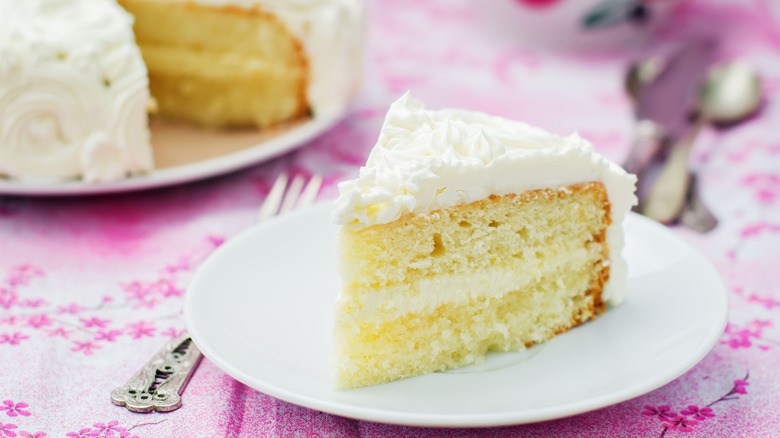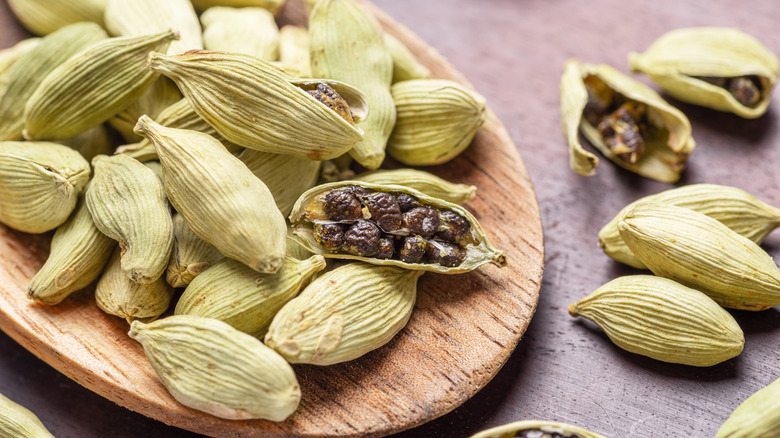The Vanilla Extract Swap That Adds A Touch Of Spice To Your Cakes
We may receive a commission on purchases made from links.
Baking cakes often requires attention to detail and a rigid adherence to the recipe, but sometimes there's room for flexibility. That could involve upgrading a basic box cake with ingredients such as coffee, booze, or banana. Other times, it's an ingredient swap; maple syrup can replace vanilla extract in a pinch, for example, and buttermilk can stand in for water (or vice versa). There are also swaps you might not even realize you can make that work beautifully. Such is the case with using cardamom extract in place of vanilla.
Vanilla brings a dark, rich, sweet-and-spice note and a ton of aromatics. Cardamom, meanwhile, is also aromatic, but with a grassier, herbaceous character. In recipes, it's possible to swap out other spices for cardamom, including a blend of ginger, nutmeg, and clove. That mix of sweet, savory, pungent, and spicy is the same reason replacing vanilla with cardamom works so well.
What is cardamom extract and how do you use it?
Cardamom is a seed pod harvested from several plant varieties that is commonly ground into a fine powder or used whole. It's used frequently in South Asian, Middle Eastern, and Southeast Asian cooking; if you enjoy chai tea or garam masala, it's in part due to cardamom. While there are two types of cardamom, green (harvested young, herbaceous) and black (harvested later, dried over a smoky fire), here we're talking green cardamom, one of the more uncommon spices you should cook with.
The extract is made the same way vanilla extract is: Pods are placed in an alcohol solution for several days or months, which extracts the oils and phenols. You end up with a flavorful, aromatic tincture which can be used sparingly to enhance recipes or make cooking easier. Some recipes call for ground cardamom seeds instead. Doing that yourself involves removing seeds from the green pods before fine-grinding them. Extract can often stand in when speed or convenience are helpful. Some people prefer the extract, since it blends in seamlessly with no textural change to frostings or creams.
Swapping vanilla out for cardamom
The swap is simple, using the same measurements in the recipe. We tested a vanilla cake recipe which called for a whopping tablespoon of extract, making it great for comparisons. Different cakes and buttercream frostings incorporated real vanilla extract (a specific type of vanilla) and a cardamom extract from spice company Burlap & Barrel. The cakes were blind tasted by three people, who considered aroma, flavor, and overall vibe.
The differences were noticeable from the beginning. Vanilla, being dark brown, lends a hint of yellow or sepia to both batter and frosting. Cardamom extract is clear and nearly colorless. Aromatically, the vanilla smelled like, well, vanilla, while the cardamom evoked grassiness and freshness, with a mineral aromatic note. The taste tests were unanimous and surprising: Cardamom was the winner. The sense was that cardamom made the recipe slightly lighter and fresher, while the vanilla seemed to add a hint of perceived sweetness and heaviness. In both cases, flavor differences were subtle unless compared side-by-side. If you're swapping out of necessity, it's unlikely anyone will notice unless a vanilla aromatic is required.
Cardamom extract can also shine in buttermilk pancakes, pumpkin bread, and more, to great effect. Just make sure you're getting a cardamom extract designed for baking, rather than a health supplement. In addition to the previously mentioned brand, you can also find extracts from Silver Cloud and Saena Baking Co. Just as with vanilla extracts, you may find you have a favorite.


